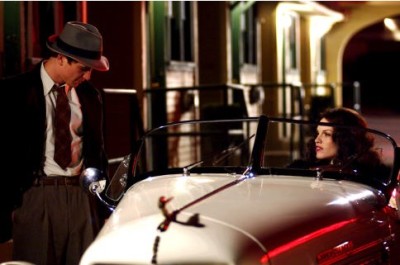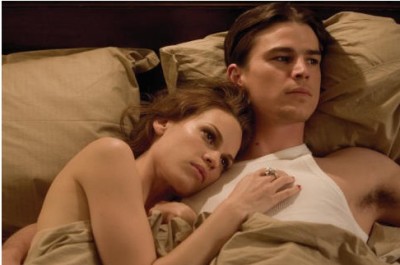By: debbie lynn elias
In addition to last week’s HOLLYWOODLAND, I have anxiously awaited this latest entry of what would hopefully become a film noir classic – THE BLACK DAHLIA. Long mesmerized by the true life story of the horrific, and yet unsolved, murder of 22-year old wannabe actress Elizabeth “Betty” Short, I first learned of the crime thanks to an excellent 1975 telemovie starring Lucie Arnaz entitled “Who Is the Black Dahlia?” Intriguingly lensed and related, that was my first foray into the mystery surrounding the 1947 discovery of the nude body of Betty Short. Nicknamed “The Black Dahlia” because she always wore black, her mutilated body was found surgically dissected in a vacant Los Angeles lot. Sadly, after seeing Brian De Palma’s newest take on the crime, I wish that 1975 film had been my last.
Based on the superb novel of the same name by James Ellroy, this is the story of LAPD homicide detectives Dwight “Bucky” Bleichert and Leland “Lee” Lee Blanchard, the crime that led them to discover The Black Dahlia and their subsequent investigation Former boxers known as Fire and Ice, Bucky and Lee are as different as night and day. Lee is the rough and tough, go-get ‘em kinda cop – ready for anything the LA underbelly can toss at him. Bucky, on the other hand, is more methodical and calculating, the cool, calm and collected type.
On a stakeout in one of LA’s more unsavory neighborhoods, their tacit surveillance turns into a shootout which unfortunately leads to their targeted suspect escaping. Intent on pursuit, the situation takes goes 180 degrees in the opposite direction as they stumble upon a body, a mutilated body of a young woman. Severed in two with surgical precision, disemboweled, blood drained as was done in Egyptian mummification, her head bludgeoned, the site is more than the boys can handle. Making the scene even more grotesque is the extended Jack Nicholson-like smile cut into the face of the victim. Given the magnitude and malevolence of the crime, the police elect to withhold evidence and detail from the public.
Eventually getting an ID on the body, Bleichert and Blanchard slowly learn of “The Black Dahlia.” Thanks to interviews with acquaintances (no family was found), a picture of Betty Short begins to develop. A party girl who had a shine for men in uniform, she was everybody’s good-time girl and full of dreams – dreams of stardom and fame and fortune. But beyond that, the trail was cold – very cold. Discovering a screen test of Betty, Bleichert becomes intoxicatingly infatuated with Betty. Adding a little more fuel to the fire is the involvement of his girlfriend Kay with Betty. Ah yes, the plot thickens. Blanchard, however, has a completely different reaction to the entire investigation thanks in large part to the imminent release of some low life he put away years ago.
Taking the lead from Kay, Bleichert uncovers a potential lesbian angle in Betty’s life which may, or may not, be a factor in her death. Putting one foot in front of the other, he follows clues that lead him to the ritzy – and well connected, upper crust Madeleine Linscott. Bearing a striking resemblance to the decedent, it’s not long before Bleichert and Linscott are involved in a tryst of their own – a tryst of deadly consequences, not to mention untold intrigue and corruption within the LAPD, the City and the well known Sprague crime family.
Josh Hartnett takes on the challenging role of the brooding Bucky Bleichert with minimal success. An intent actor, he seems overwhelmed by the magnitude of the myth and mystery of the murder and Bleichert’s investigation. Bland and boring are the watchwords for his performance and his narration – especially when compared to other actors who have undertaken this same character with more power and conviction. Aaron Eckhart, on the other hand, is the antithesis of Hartnett and is riveting as Sgt. Leland Blanchard. Walking a tightrope between sanity and insanity, good versus evil, he is primary reason to watch this film. Scarlett Johansson is beauteous as Kay Lake, but her performance gets lost in the muddle and mire of a bogged down script. And Hilary Swank just doesn’t cut it as the swanky rich girl, Madeleine Linscott. Unbelievable and uninspired, she is a disappointment of gargantuan proportions. One of the most enjoyable performances, however, comes from Mia Kirschner. As the title character, Kirschner is liberating.
The Ellroy novel on which the film is based is of the highest caliber and a book I have read uninterrupted numerous times. Unfortunately, Josh Friedman’s screenplay and Brian De Palma’s direction eliminate a myriad of subplots that are germane to the story while keeping others that just add murk and mire to the existing murder mystery and don’t translate well to the big screen. Friedman fails miserably at juxtapositioning the true crime and the fictionalized work. And unfortunately, one of the worst scenes of the entire film is that which ties all the loose ends together. Convoluted, long winded and completely confusing, any conclusions that you as a moviegoer may have drawn up to this point, will fly out the window with a resounding “huh?” Part of the problem may have been De Palma’s personal desire to infect the story with his belief that the crime scene photos may have been manipulated or manipulated the investigating officers – almost as if they were Elizabeth Short’s head shots or glossies. Elizabeth Short and James Ellroy’s fictionalized account of her murder deserve better than what De Palms puts on screen.
One beautiful aspect of the film is Vilmos Zsigmond’s cinematography. Exquisitely precise and telling, his nuanced black and white footage of Elizabeth Short’s screen test blended with the art deco production design is visual rapture and does much to bring life to the victim’s character.
The most worthwhile aspect of the entire project is the art deco production and costume design. Shot on location in Bulgaria, Dante Ferretti’s production design is masterful, capturing every minuscule detail of 1947 Los Angeles and Hollywood. Jenny Beaven’s costuming completes the picture as she incorporates the style and feel of every aspect of the period from blue collar working stiffs to “working girls” and wannabe actresses to society’s elite. And quite frankly, I wouldn’t mind having some of the jewelry used in my personal wardrobe!
And although De Palms wanted Academy Award winning composer James Horner to score the film, second choice Mark Isham is first rate, filling the emotional voids of the acting with suspenseful emotion.
A lover of not only film noir, but the grandeur and grotesqueness of early Hollywood and Los Angeles, the only thing given to me by the THE BLACK DAHLIA is a black hole of disappointment. I think it’s time to revisit the novel.
Bucky Bleichert – Josh Hartnett Kay Lake – Scarlett Johansson Lee Blanchard – Aaron Eckhart Madeleine Linscott – Hilary Swank Elizabeth Short – Mia Kirshner
Directed by Brian De Palma. Written by Josh Friedman, based on the novel by James Ellroy. Rated R. (121 min)












